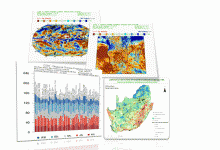Climate and air quality modelling
The negative effects of climate change on a global and national scale needs collection of accurate data on the climate system at various spatial and time scales. The CSIR has invested in the development of a capability to perform seamless climate model simulations. This comprises statistical and dynamic downscaling experiments of climate change projections, medium and short-range numerical weather predictions using a state of the art Earth System Model-based (ESM), framework.
The earth system model outputs and meteorological observations provide a wonderful opportunity to develop scientific evidence of variability as well as long term changes in the climate system. Such information is key to the development and implementation of climate change policies, adaptation measures and extreme weather events response planning and coordination in South Africa. To this effect, availed ESM based decision-support information include climate timescale projections, short to medium-range early warning, and tailor-made advisory information thereby helping sectors of the economy to build resilience against weather variability and climate change-induced hazards. The developed regional model outputs find applications in impact modelling of risk and vulnerability for sectors of the economy such as water, energy, transport, coastal systems, health, agriculture, forestry, fisheries, infrastructure and biodiversity. The focus of the regional modelling research covers high-resolution studies over South Africa and the African continent. Global model outputs are developed only at coarse spatial resolution.
Air pollution is a growing issue in South Africa as well as the rest of Africa, with many African countries not on track to meet the air quality related Sustainable Development Goals (Sachs et al., 2020). Air quality in South Africa often exceeds the National Ambient Air Quality Standards, with particulate matter and ground-level ozone driving many of these exceedances. In order to improve air quality, a rigorous evidence base that uses local information is necessary to understand not only sources of pollution and pollution levels, but also to characterise impacts, assess effectiveness of planned policies, and understand the linkages between air quality and climate change, and their combined impacts.
In order to provide actionable information for stakeholders, the CSIR team uses their extensive modelling expertise to simulate emissions, ambient (i.e. outdoor) air quality concentrations, and resultant impacts. Working with researchers in Climate Services Research Group the team also explores the linkages between air quality and climate change, as well as integrated vulnerability assessments. The CAQM uses the publicly available and open-source CAMx (www.camx.com) Chemistry Transport Model for their air quality simulations; which is a state-of-the art model that includes recent advances in full chemistry and atmospheric models. It is a Eulerian grid based chemistry model able to simulate gaseous and aerosol species at a range of scales and resolutions and includes features such as source tracking and parallelization. The CAQM modelling platform has also coupled (offline) CSIRO ESM and CAMx in order to simulate air quality under a changing climate.
Capabilities:
- State-of-the-art climate modelling (in collaboration with CSIRO):
- Radiative forcing.
- Dynamic aerosol effect.
- Dynamic river-routing scheme (that feeds freshwater to oceans)
- Terrestrial carbon dioxide flux (vegetation-atmosphere interaction).
- Seasonal forecasting
- Regional downscaling
- Chemical transport modelling of atmospheric composition
- Long-term multi-year simulations.
- Source tracking.
- Scenario modelling.
- Sensitivity analysis.
- Quantifying impacts of air quality.
- Emissions modelling and inventories
- All non-industrial sectors; including on-road vehicles, biogenic VOC, domestic fuel combustion, wind-blown dust, informal waste burning.
- Scenario development and associated emission estimation.
- Air quality management planning


